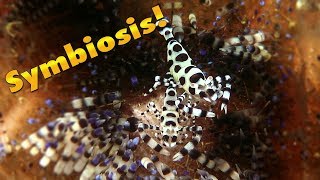Coming up next on Jonathan Bird's Blue World, a look at symbiosis in the ocean!
接下来请收看乔纳森·伯德的蓝色世界,看看海洋中的共生关系!
Hi, I'm Jonathan Bird and welcome to my world!
嗨,我是乔纳森·伯德,欢迎来到我的世界!
Many creatures in the ocean survive by forming relationships or partnerships with other creatures. Perhaps the most famous is that of the anemone and the anemone fish (sometimes called a clownfish).
许多海洋生物通过与其他生物建立关系而生存,也许最著名的算是海葵和海葵鱼(有时也叫为小丑鱼)。
An anemone is an invertebrate that looks like a carpet, with stinging tentacles. It’s basically a jellyfish that can’t swim.
海葵是一种无脊椎动物,看起来像地毯,有很多有刺的触角。它基本上是一种不会游泳的水母。
It stings and kills fish to eat with these tentacles. But this fish, the clownfish, lives in the anemone’s tentacles without injury because its coated with a special slime that tells the anemone not to sting.
它用这些触角来刺伤和杀死鱼。但是这种鱼小丑鱼,生活在海葵的触角里却不会受伤,因为它身上覆盖着一层特殊的粘液,告诉海葵不要刺伤它。
The anemone provides protection for the fish. This is a perfect example of symbiosis.
海葵为鱼提供保护,这是共生的完美实例。
The word symbiosis comes from the Greek, meaning "living together" but it refers to creatures that have a relationship, not just the ones that are living together.
“共生”这个词来自希腊语,意思是“一起生活”,但它指的是彼此之间存在关系的生物,而不仅仅是生活在一起的生物。
In the case of the clownfish and the anemone, they do live together. This is how most people think of symbiosis.
就小丑鱼和海葵而言,它们确实生活在一起。这就是大多数人对共生的看法。
But take the example of the cleaning station. At a cleaning station, one kind of fish gets cleaned by another--such as this manta ray being cleaned by a bunch of wrasses.
但以清洁站为例。在一个清洗站,一种鱼帮助另一种鱼清洗,比如一堆濑鱼在帮这条蝠鲼清洗。
It hovers over the reef and the wrasses come right over to pick the parasites from its gills.
它盘旋在珊瑚礁上,而濑鱼则直接游过来从它的鳃上取食寄生虫。
This is symbiosis, but the two animals definitely don’t live together.
这是共生关系,但这两种动物并不生活在一起。
And that’s not the only thing confusing about symbiotic relationships!
这并不是唯一让人困惑的共生关系!
Although we tend to think of symbiotic relationships as being beneficial to both parties, that’s not always the case.
虽然我们倾向于认为共生关系对双方都有利,但情况并非总是如此。
Take the case of the remora. A remora is a fish with a suction cup on its head that allows it to stick to larger animals like sharks, dolphins and turtles.
以鮣鱼为例。鮣鱼是一种头部带有吸盘的鱼,它可以吸附在鲨鱼、海豚和海龟等体型较大的动物身上。
The remora survives by mooching food scraps and a free ride from its host.
鮣鱼靠吃食物残渣为生,还可以搭宿主的便车。
They may provide some cleaning services to their host, but for the most part, they seem to be freeloaders.
它们可能会为宿主提供一些清洁服务,但大多数情况下,它们似乎都是白食客。
This is definitely a symbiotic relationship, but it’s really only good for one party.
这绝对是一种共生关系,但它只对一方有利。
If the remora were to harm the host in some way, you would call it a parasite.
如果鮣鱼以某种方式伤害宿主的话,就可以把它叫做寄生虫了。
If the remora merely helps itself without harming the host, then this would be called a commensal relationship or commensalism.
如果鮣鱼只是帮助自己而不伤害宿主,那么可以称其为共栖关系或共栖。
Parasites are common in the ocean, but sometimes harder to film. Meet the Anilocra isopod, a blood-sucking crustacean that attaches itself permanently to a reef fish.

寄生虫在海洋中很常见,但有时更难拍摄到。来见见这种等足类动物,它是一种吸血甲壳类动物,永久地附着在珊瑚鱼上。
Like a mosquito, it lives by sucking its host’s blood, but the poor fish can never get rid of it!
它像蚊子一样,靠吸吮主人的血来生活,但可怜的鱼却永远也摆脱不了它!
Now that’s a parasite—it helps itself but harms the other animal.
既然这是一种寄生虫,它会帮助自己,但会伤害其他动物。
A partnership that’s good for both parties is called mutualism.
对双方都有利的伙伴关系被称为互惠主义。
For example, take this hermit crab. She has a garden of small anemones on her shell that she carries everywhere she goes.
例如,以这个寄居蟹为例。她贝壳上有一个小海葵花园,她去哪都带着它。
The anemones give her protection from predators like octopus because their stinging tentacles pack a punch.
海葵能保护她免受像章鱼这样的掠食者的伤害,因为它们的刺状触须会产生冲击力。
But the anemones have a great life living on her shell because they gather some of the scraps from her messy eating, and they travel around with her to the next meal.
但是海葵在它的壳上生活得很好,因为它们收集寄居蟹狼吞虎咽过后的残羹剩饭,还和它一起四处旅行,寻找下一餐。
Since the hermit crab uses an old snail shell for a home, she needs to find a larger shell every once in a while as she grows.
因为寄居蟹用一个旧蜗牛壳当家,随着它不断长大,需要寻找一个更大的壳。
When she finds one, it’s as simple as hopping out of the old shell and into the new one.
当她找到一个时,就从旧壳跳到新壳,超简单。
But what to do about the anemones? The anemones are so important to the hermit crab that she must also move them to the new shell.
但海葵怎么办呢?海葵对寄居蟹非常重要,所以必须把它们也移到新壳上。
Without them, she is defenseless. Slowly, with a combination of tapping on the anemones and peeling their edges, the hermit crab convinces them to release their grip.
没有它们,寄居蟹无法自卫。它拍打海葵,并剥动它们的边缘,慢慢地说服海葵放手。
Only the crab knows how to coax the anemones into letting go. They will not submit to any other creature pulling on them.
只有寄居蟹才知道如何哄海葵松手。海葵不会屈听从其他的生物的拉扯。
Once the anemone lets go of the old shell, the hermit crab deposits it on her new shell.
一旦海葵放开旧壳,寄居蟹就把它放到新壳上。
She simply plops it in place and holds it until the anemone grabs on.
它简单地把它放在适当的位置上,海葵会抓住壳。
The anemone will then crawl around on the shell and find a good spot all on its own, while the hermit crab turns her attention to working on the next anemone.
然后,海葵在壳上爬来爬去,自己找到一个舒服的地方,寄居蟹则把注意力转向下一个海葵。












